The Parasitic attacks in forested areas pose a significant threat to forest health and, consequently, for the global ecosystem. In recent decades, the incidence and severity of these attacks have increased, accomplices the climate change, globalization and the reduced biodiversity.
The threat of parasites
Forest pests can be insects, mushrooms, bacteria or virus, each of which causes different damage. Insects, such as the Bark beetle printer (Ips typographus), are among the most devastating pests for conifers. These beetles attack trees weakened by environmental stress, digging tunnels under the bark, interrupting the flow of nutrients and leading to the death of the tree, with the creation of dead areas that can spread rapidly.
Mushrooms, like The pathogen of theHoney fungus, attack both the roots and the trunk of the trees, causing rot and deathThe spread of these fungi is often favored by humidity and temperature conditions that are becoming increasingly common with climate change. Bacteria and viruses, while less common, can also cause serious damage, often through infections that weaken trees and make them more susceptible to other pests.
Contributing factors
The climate change plays a crucial role in increasing parasitic attacks. Warmer temperatures And prolonged periods of drought weaken trees, making them more vulnerable to attack. Furthermore, Rising temperatures allow many parasites to extend their range and reproduce faster, intensifying the damage.
Globalization has facilitated the transport of parasites from one region to another.. Many invasive pests have no natural predators in new areas, allowing them to proliferate unchecked. This phenomenon is exacerbated by forest monoculture, where the lack of genetic diversity facilitates the spread of parasites.
Consequences and solutions
Parasitic attacks can cause huge economic losses, reducing the availability of wood and increasing forest management costs. Furthermore, the loss of trees reduces the capacity of forests to absorb CO2, further contributing to climate change.
To combat these problems, it is essential to adopt integrated forest management strategies. These include the use of biopesticides and biological control methods, such asintroduction of natural predators. Furthermore, it is essential Promoting diversity in forest plantations to reduce vulnerability to parasitic attacks.
Finally, thesatellite analysis, like our DSS Watch, it turned out very useful for monitoring the spread of the attack, managing to quickly identify the most affected areas.
Its effectiveness is also due to the fact that it works on very large surfaces that are difficult to monitor with the naked eye, as hard to reach areas.
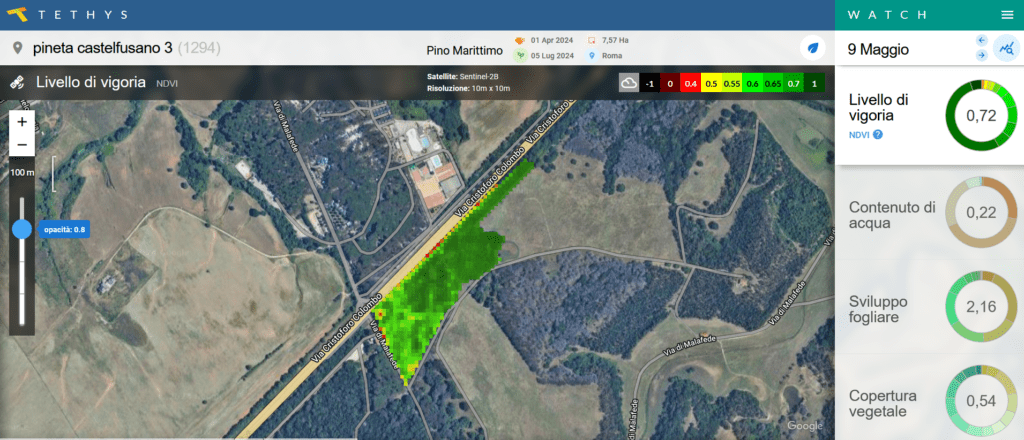
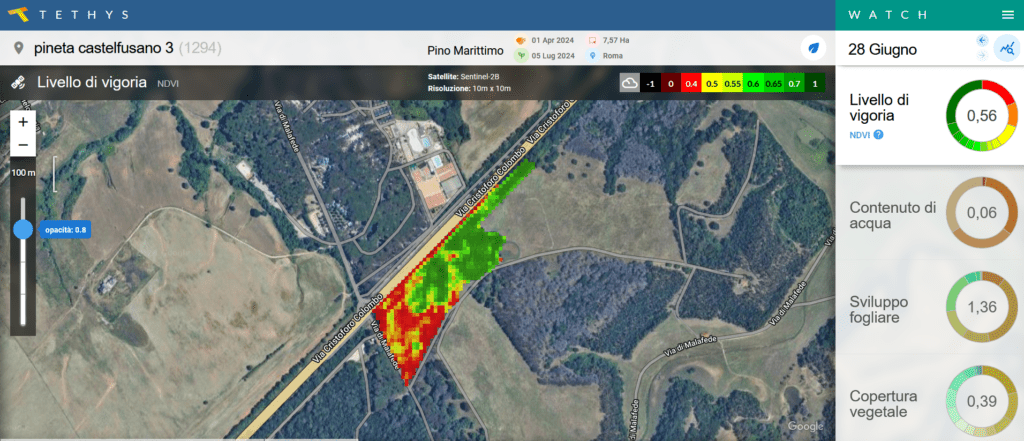
Castelfusano pine forest attacked by cochineal
There Pine forest of Castel Fusano, the largest public green area in Rome, covers 916 hectares and hosts a rich vegetation of holm oak and stone pine. This urban park, located in the municipality of Rome, was established in 1980 by the Lazio Region as protected natural area and, since 1996, it has been part of the Litorale Romano State Nature Reserve.
Starting for some years the pine forest has been attacked by the tortoise scale insect (Toumeyella parvicornis), an alien parasite that before developing throughout the city had reached the pine trees in the south-west quadrant of the capital.
The tortoiseshell cochineal is a pine tree parasitic insect from North America, its range extends from southern Canada to northern Mexico. In its native environment it is not a particularly harmful species for trees because its diffusion is limited by a series of predators, including various species of ladybugs, some caterpillars, spiders and birds.
In Rome has been present since at least mid-2018, when it was found on some pine trees in the south-east of the city. Initially it infested the trees in the Eur, Torrino and Mostacciano districts, but It has spread rapidly and has now attacked over a third of the pine trees in the protected area, spreading over a vast territory, devouring plants even inside the presidential estate of Castel Porziano.
How can we intervene?
There Lazio Region, on August 31, 2021, published the resolution 548, containing the mandatory phytosanitary measures to combat Toumeyella Parvicornis. In these measures, in addition to the mapping of the areas affected by the phenomenon, it is prescribedmandatory nature of treatmentsOne of the methods of intervention consists in endotherapeutic treatments, or infiltration of insecticidal solutions into the tree trunk. This method aims to kill the parasite that feeds on sap, preserving at the same time the health of the treated pine.
This procedure, which involves Tree-by-tree liquid injections, however, does not guarantee certain and definitive effectiveness. However, it's difficult, due to its size and costs, replicate this scheme annually across entire pine forests and woods.




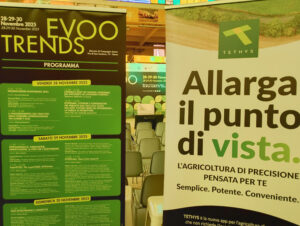

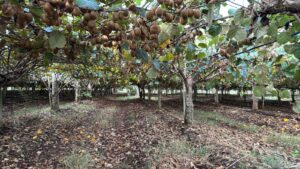
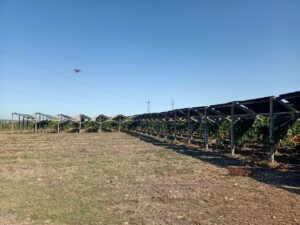


Add comment
You must be logged in to post a comment.